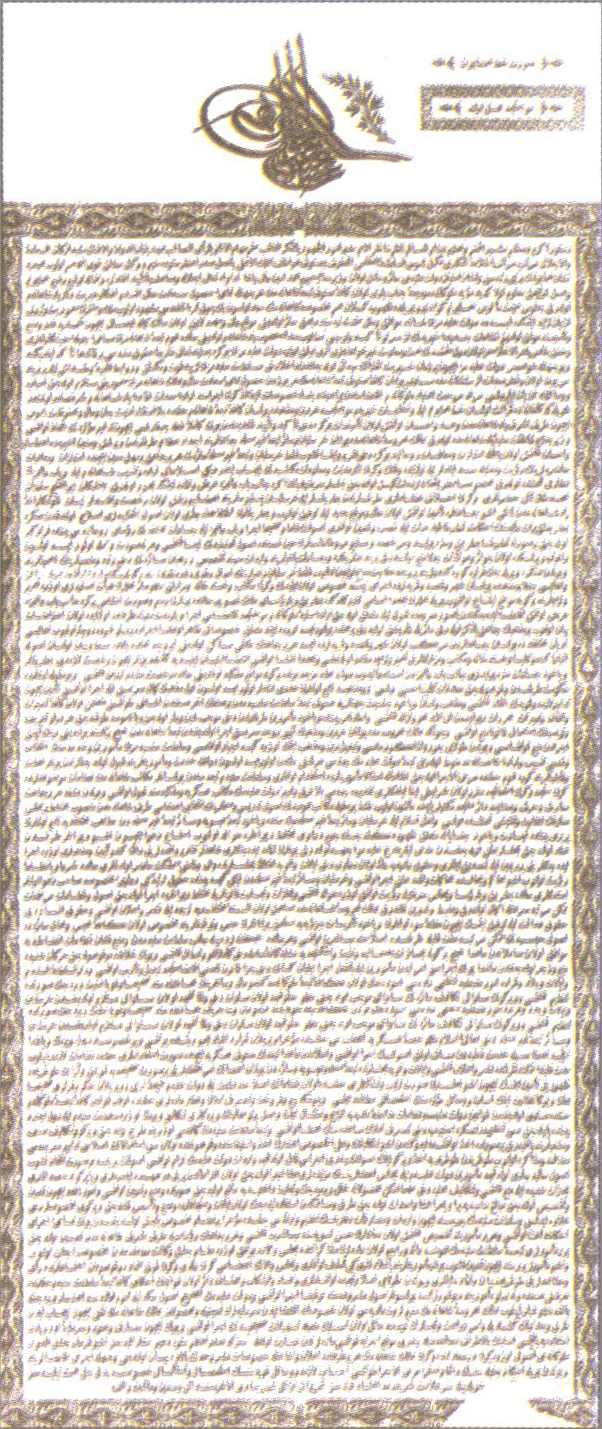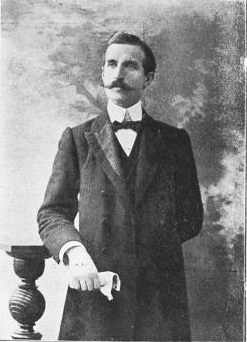|
Tanzimât
The Tanzimat (; ota, تنظيمات, translit=Tanzimāt, lit=Reorganization, ''see'' wikt:نظام, nizām) was a period of reform in the Ottoman Empire that began with the Edict of Gülhane, Gülhane Hatt-ı Şerif in 1839 and ended with the First Constitutional Era in 1876. The Tanzimat era began with the purpose, not of radical transformation, but of modernization, desiring to consolidate the social and political foundations of the Ottoman Empire. It was characterised by various attempts to modernise the Ottoman Empire and to secure its territorial integrity against internal nationalism, nationalist movements and external aggressive powers. The reforms encouraged Ottomanism among the diverse ethnic groups of the Empire and attempted to stem the tide of the rise of nationalism in the Ottoman Empire. Historian Hans-Lukas Kieser has argued that the reforms led to "the rhetorical promotion of equality of non-Muslims with Muslims on paper vs. the primacy of Muslims in practice"; ... [...More Info...] [...Related Items...] OR: [Wikipedia] [Google] [Baidu] |
Liberalism In Turkey
This article gives an overview of liberalism in Turkey. Liberalism was introduced in the Ottoman Empire during the Tanzimat period of reformation. History On 30 May 1876, Murad V became the Sultan when his uncle Abdülaziz was deposed. He was highly influenced by French culture and was a liberal. He reigned for 93 days before being deposed on the grounds that he was supposedly mentally ill on 31 August 1876; however his opponents may simply have used those grounds to stop his implementation of democratic reforms. As a result, he was unable to deliver the Constitution that his supporters had sought.Palmer, Alan. ''The Decline and Fall of the Ottoman Empire'', 1992. Page 141–143. Constitutional era Constitutionalism was introduced in the Ottoman Empire by liberal intellectuals like Beşir Fuad, Hekim Ismail Pasha, and Ahmed Zühdü Pasha, who tried to modernize their society by promoting development, progress, and liberal values. Tanzimât The Tanzimât, literally me ... [...More Info...] [...Related Items...] OR: [Wikipedia] [Google] [Baidu] |
Edict Of Gülhane
The Gülhane Hatt-ı Şerif ("Supreme Edict of the Rosehouse"; french: Hatti-Chérif de Gulhané) or Tanzimât Fermânı ("Imperial Edict of Reorganization") was a proclamation by Ottoman Sultan Abdülmecid I in 1839 that launched the Tanzimât period of reforms and reorganization in the Ottoman Empire. The 125th anniversary of the edict was depicted on a former Turkish postcard stamp. The proclamation was issued at the behest of reformist Grand Vizier Mustafa Reşid Pasha. It promised reforms such as the abolition of tax farming, reform of conscription, and guarantee of rights to all Ottoman citizens regardless of religion or ethnic group. The goal of the decree was to help modernize the empire militarily and socially so that it could compete with the Great Powers of Europe. It also was hoped the reforms would win over the disaffected parts of the empire, especially in the Ottoman controlled parts of Europe, which were largely Christian. At the time of the edict, millets (i ... [...More Info...] [...Related Items...] OR: [Wikipedia] [Google] [Baidu] |
Mahmud II
Mahmud II ( ota, محمود ثانى, Maḥmûd-u s̠ânî, tr, II. Mahmud; 20 July 1785 – 1 July 1839) was the 30th Sultan of the Ottoman Empire from 1808 until his death in 1839. His reign is recognized for the extensive administrative, military, and fiscal reforms he instituted, which culminated in the Decree of Tanzimat ("reorganization") that was carried out by his sons Abdulmejid I and Abdülaziz. Often described as "Peter the Great of Turkey", Mahmud's reforms included the 1826 abolition of the conservative Janissary corps, which removed a major obstacle to his and his successors' reforms in the Empire. The reforms he instituted were characterized by political and social changes, which would eventually lead to the birth of the modern Turkish Republic. Notwithstanding his domestic reforms, Mahmud's reign was also marked by nationalist uprisings in Ottoman-ruled Serbia and Greece, leading to a loss of territory for the Empire following the emergence of an independ ... [...More Info...] [...Related Items...] OR: [Wikipedia] [Google] [Baidu] |
Millet System
In the Ottoman Empire, a millet (; ar, مِلَّة) was an independent court of law pertaining to "personal law" under which a confessional community (a group abiding by the laws of Muslim Sharia, Christian Canon law, or Jewish Halakha) was allowed to rule itself under its own laws. Despite frequently being referred to as a "system", before the nineteenth century the organization of what are now retrospectively called millets in the Ottoman Empire was not at all systematic. Rather, non-Muslims were simply given a significant degree of autonomy within their own community, without an overarching structure for the 'millet' as a whole. The notion of distinct millets corresponding to different religious communities within the empire would not emerge until the eighteenth century. Subsequently, the existence of the millet system was justified through numerous foundation myths linking it back to the time of Sultan Mehmed the Conqueror (r. 1451–81), although it is now understood that ... [...More Info...] [...Related Items...] OR: [Wikipedia] [Google] [Baidu] |
Şayeste Hanım
ota, شائسته خانم , birth_date = 1838 , birth_place = , death_date = , death_place = Çengelköy Palace, Constantinople (now Istanbul), Ottoman Empire , burial_place = Şehzade Ahmed Kemaleddin Mausoleum, Yahya Efendi Cemetery, Istanbul , spouse = , issue = , issue-link = #Issue , issue-pipe = more... , house = Ottoman (by marriage) , father = , mother = , religion = Sunni Islam Şayeste Hanım (; ota, شائسته خانم; 1838 – 11 February 1912) was the seventeenth wife of Sultan Abdulmejid I of the Ottoman Empire. Early life Of Circassian origin, Şayeste Hanım was born in 1838. She had one sister, Hüsnidil Hanım, who was the wife of a certain Safvet Pasha. She was also related to Kabasalal Çerkes Mehmed Pasha. Marriage Şayeste married Abdulmejid in 1851, and was given the title of "Seventh Ikbal". A year after the marriage, on 3 February 1853, she gave birth to her first child, a stillborn ... [...More Info...] [...Related Items...] OR: [Wikipedia] [Google] [Baidu] |
Rahmi Arslan
Mustafa Rahmi Arslan (1874 –1947) was a Turkish politician, who was a prominent member of the Committee of Union and Progress (CUP).. During the First World War, Rahmi Bey went to significant lengths to protect the Christian and European populations of Smyrna from deportation, exile and murder; often defying direct orders from the Ottoman Government in Istanbul. Education and early life Rahmi Arslan was born into a wealthy family in Selanik and attended primary school in his hometown. He studied law in Constantinople, but shortly before the completion of his studies, he was arrested and prosecuted for his membership in the CUP, following which he left the Ottoman Empire and went into exile in Europe. Political career It was in exile in Geneva, where got to know CUP co-founder Abdullah Cevdet, with whom he tried to establish a Geneva branch of the CUP in the 1890s. By 1906, together with Talaat Pasha and Djemal Pasha, he was one of the co-founders of the Ottoman Fr ... [...More Info...] [...Related Items...] OR: [Wikipedia] [Google] [Baidu] |
Bow Tie
The bow tie is a type of necktie. A modern bow tie is tied using a common shoelace knot, which is also called the bow knot for that reason. It consists of a ribbon of fabric tied around the collar of a shirt in a symmetrical manner so that the two opposite ends form loops. There are generally three types of bow ties: the pre-tied, the clip-on, and the self-tie. Pre-tied bow ties are ties in which the distinctive bow is sewn onto a band that goes around the neck and clips to secure. Some "clip-ons" dispense with the band altogether, instead clipping straight to the collar. The traditional bow tie, consisting of a strip of cloth that the wearer has to tie by hand, is also known as a "self-tie", "tie-it-yourself", or "freestyle" bow tie. Bow ties may be made of any fabric material, but most are made from silk, polyester, cotton, or a mixture of fabrics. Some fabrics (e.g., wool or velvet) are much less common for bow ties than for ordinary four-in-hand neckties. Origin and hist ... [...More Info...] [...Related Items...] OR: [Wikipedia] [Google] [Baidu] |
Frock Coat
A frock coat is a formal men's coat characterised by a knee-length skirt cut all around the base just above the knee, popular during the Victorian and Edwardian periods (1830s–1910s). It is a fitted, long-sleeved coat with a centre vent at the back and some features unusual in post-Victorian dress. These include the reverse collar and lapels, where the outer edge of the lapel is often cut from a separate piece of cloth from the main body and also a high degree of waist suppression around the waistcoat, where the coat's diameter round the waist is less than round the chest. This is achieved by a high horizontal waist seam with side bodies, which are extra panels of fabric above the waist used to pull in the naturally cylindrical drape. As was usual with all coats in the 19th century, shoulder padding was rare or minimal. In the Age of Revolution around the end of the 18th century, men abandoned the justaucorps with tricorne hats for the directoire style: dress coat with bre ... [...More Info...] [...Related Items...] OR: [Wikipedia] [Google] [Baidu] |
Mehmed Cemil Bey
Mehmed Cemil Bey (1828 – 1872) was an Ottoman diplomat, who was one of the many European-educated public figures in the mid-19th-century Ottoman Empire. He represented the Ottoman Empire at the Congress of Paris, the 1856 diplomatic meeting held to make peace after the Crimean War. Early life and career Mehmed Cemil Bey was born in Constantinople as the son of Mustafa Reşid Pasha, the chief architect behind the Tanzimat reforms. He was a representative of the Ottoman Empire, alongside Mehmed Emin Âli Pasha at the Congress of Paris in 1856. He also served as an ambassador to France France (), officially the French Republic ( ), is a country primarily located in Western Europe. It also comprises of Overseas France, overseas regions and territories in the Americas and the Atlantic Ocean, Atlantic, Pacific Ocean, Pac .... References 19th-century diplomats 1828 births 1872 deaths Ambassadors of the Ottoman Empire to France {{Ottoman-bio-stub ... [...More Info...] [...Related Items...] OR: [Wikipedia] [Google] [Baidu] |
Political Corruption
Political corruption is the use of powers by government officials or their network contacts for illegitimate private gain. Forms of corruption vary, but can include bribery, lobbying, extortion, cronyism, nepotism, parochialism, patronage, influence peddling, graft, and embezzlement. Corruption may facilitate criminal enterprise such as drug trafficking, money laundering, and human trafficking, though it is not restricted to these activities. Misuse of government power for other purposes, such as repression of political opponents and general police brutality, is also considered political corruption. Over time, corruption has been defined differently. For example, in a simple context, while performing work for a government or as a representative, it is unethical to accept a gift. Any free gift could be construed as a scheme to lure the recipient towards some biases. In most cases, the gift is seen as an intention to seek certain favors such as work promotion, tipping in or ... [...More Info...] [...Related Items...] OR: [Wikipedia] [Google] [Baidu] |
Conscription
Conscription (also called the draft in the United States) is the state-mandated enlistment of people in a national service, mainly a military service. Conscription dates back to antiquity and it continues in some countries to the present day under various names. The modern system of near-universal national conscription for young men dates to the French Revolution in the 1790s, where it became the basis of a very large and powerful military. Most European nations later copied the system in peacetime, so that men at a certain age would serve 1–8 years on active duty and then transfer to the reserve force. Conscription is controversial for a range of reasons, including conscientious objection to military engagements on religious or philosophical grounds; political objection, for example to service for a disliked government or unpopular war; sexism, in that historically men have been subject to the draft in the most cases; and ideological objection, for example, to a perceived vio ... [...More Info...] [...Related Items...] OR: [Wikipedia] [Google] [Baidu] |





